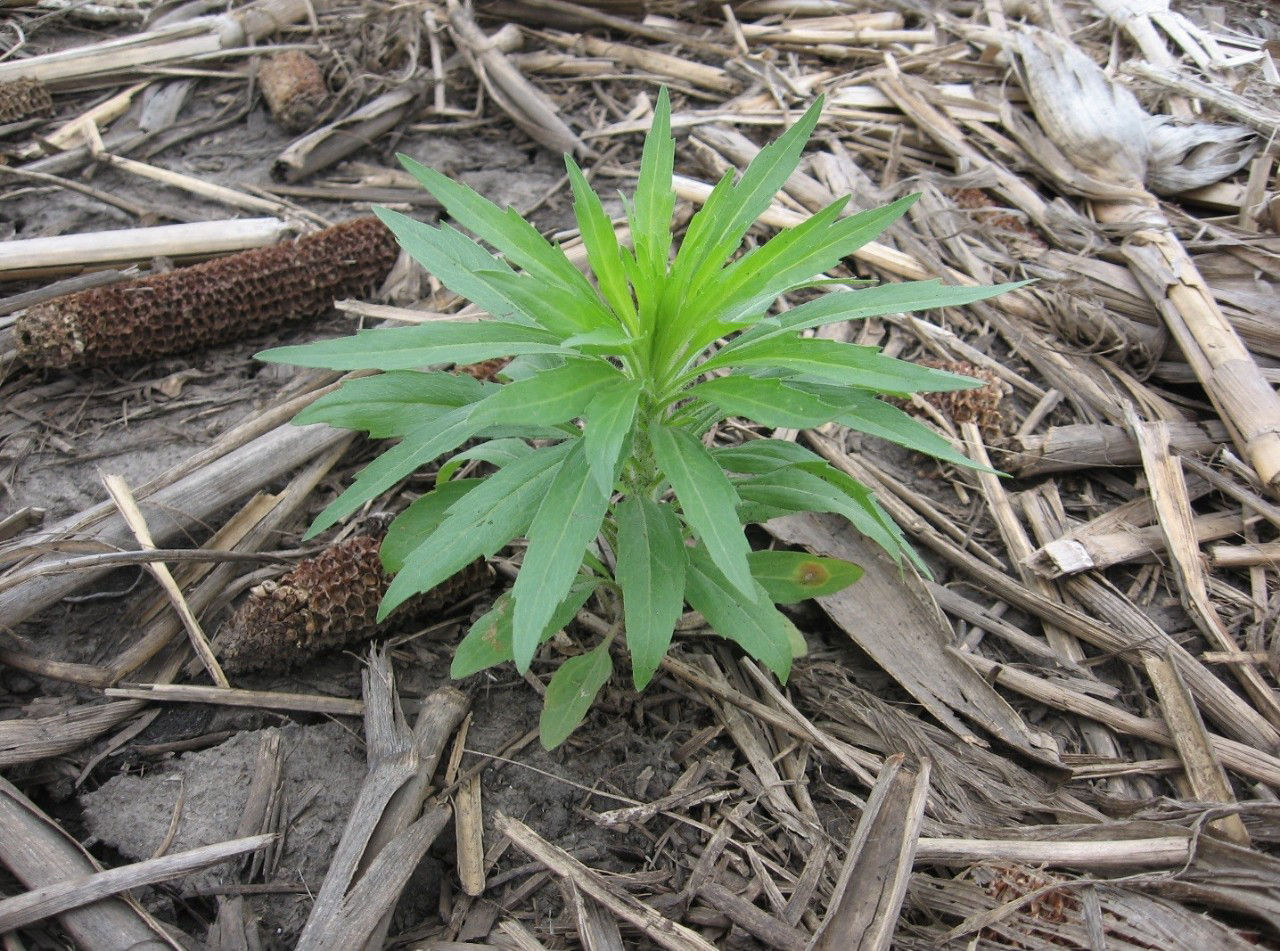Managing Early Season Marestail in Soybean
December 16, 2024
Marestail (Conyza canadensis (L.) is a problem weed for much of the Corn Belt. With its emergence window split into two periods of late summer and fall and then March through June, it has ample time to become a detriment to soybean yield potential. In a 2010 Ohio State University Extension marestail study, there was a 14 bu/acre loss when a burndown treatment failed to control emerged plants compared to an effective burndown and residual program.1 Properly controlling this weed is essential to achieving soybean yield potential.

Marestail characteristics
Marestail can overwinter in the rosette stage or emerge in the spring and early summer. Controlling while in the rosette stage in the fall with a labeled herbicide program is recommended as spring emerging plants tend to be the most challenging to control. Stems elongate from fall emerged plants and start growing (bolt) in April or May (Figure 1). Typically, spring emerged plants are a little behind their fall emerged counterparts in stem growth.
Managing in the spring
Most populations of marestail are resistant to glyphosate and some are resistant to ALS-inhibiting herbicides; therefore, using multiple modes of action against this weed is wise. Planting into an existing marestail stand should be avoided. Therefore, if tillage is not used in the spring, an effective herbicide burndown program should be used for a clean start. Tillage can be effective in controlling emerged weeds if the first few inches of soil is thoroughly mixed and existing plants are dislodged. It is easiest to control when the plant is still in the rosette stage prior to bolting.
There are many available burndown options. Those containing 2,4-D ester, glyphosate (for grass control) and possibly the addition of saflufenacil, paraquat, or glufosinate are effective when following labeled application requirements. Combining these with a robust residual program that prevents future weeds from emerging is the most reliable way to combat this weed. If 2, 4-D is used in a burndown application, prior to planting soybeans, waiting intervals of not less than 7 days for rates of 0.75 to 1.0 pt/acre and not less than 15 days for rates of 1 to 2 pt/acre are required, respectively. Adding dicamba to an early spring burndown is also an option. However, DO NOT exceed 12.8 fl oz/acre of dicamba in a spring burndown application prior to planting soybeans. Additionally, if dicamba is used in a burndown, prior to planting soybeans, waiting intervals of 14 days for 6.4 fl oz/acre or less and 28 days for 12.8 fl oz/acre are required, respectively. Adding an appropriately labeled dicamba herbicide to an early spring burndown is also an option for corn ground, provided all required plant back restrictions are adhered to. Metribuzin has burndown and residual activity and works well with paraquat, glufosinate, or saflufenacil.
Starting clean is the first step then the next step is using residual herbicides to control emerging weeds. This can be done with applying PPO containing herbicides like flumioxazin, sulfentrazone, and a Group 5 product like metribuzin. Use the highest rates labeled for the planting timing and soil type. Saflufenacil products cannot be applied in a mixture with other PPO-inhibiting (Group 14) herbicides including flumioxazin, sulfentrazone, and fomesafen herbicide products.
After soybean emergence, post applied herbicides like Liberty® herbicide can be used in XtendFlex® Soybeans, LibertyLink® Soybeans, or Enlist E3® Soybeans. Control is maximized when weeds don’t exceed six inches. Since Liberty® herbicide is a contact herbicide, a spray volume of at least 15 gpa is needed. See label for specific application instructions.
No dicamba may be used in-crop with seed with Roundup Ready® Xtend Technology, unless and until approved or specifically permitted, and no dicamba formulations are currently registered for such use in the 2025 season. Please follow https://www.roundupreadyxtend.com/pages/xtendimax-updates.aspx for status updates. Dicamba may harm crops that are not tolerant to dicamba.
While marestail is a challenging weed to control, many options exist for management. Always consult the herbicide labels to understand application requirements.
Channel Agronomist
Brian Denning
Sources
1Loux, M. and Johnson, B. 2013. Control of marestail in no-till soybeans. Ohio State University Extension, The Ohio State University and Purdue University Extension, Purdue University. https://ag.purdue.edu/btny/purdueweedscience/wp-content/uploads/2021/02/marestail-fact-2014-latest.pdf
Loux, M.M. and Johnson, B. 2019. Managing marestail in no-till soybeans. ANR-72. Ohioline. Ohio State University Extension. The Ohio State University. https://ohioline.osu.edu/factsheet/anr-72
Web sites verified 10/16/24 1110_465401